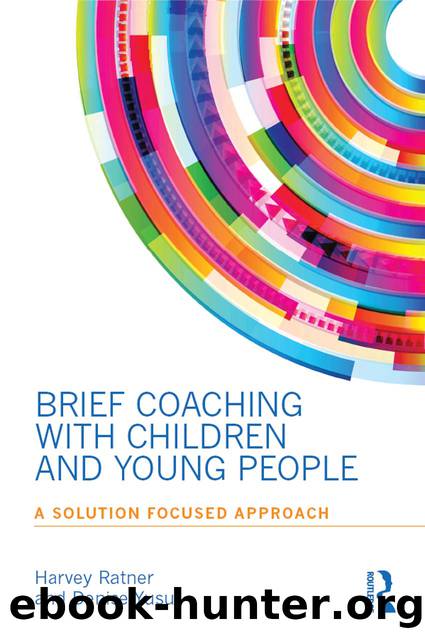Brief Coaching with Children and Young People by Harvey Ratner & Denise Yusuf

Author:Harvey Ratner & Denise Yusuf
Language: eng
Format: epub
ISBN: 978-1-317-58986-0
Publisher: Routledge
Chapter 5
Groupwork
Groupwork is an important mode of working with young people. Partly it’s a matter of convenience: in a setting such as a school, it provides a way to work with several young people at once. It is a way to impact on the peer group, and so, in some areas of work, for example with gangs, it avoids targeting particular individuals as being in need of ‘help’. There is also the usefulness of giving individuals the opportunity to learn from, and to contribute to, the others in the group. Even when every participant’s issues are different there is a sense of group identity that can be mutually empowering for the members.
Several books on SF groupwork are now available and we particularly recommend the work of John Sharry and Linda Metcalf (Sharry 2007; Metcalf 1998).
Setting up the group
Getting a group going is often the biggest challenge in groupwork. In certain settings, such as a school or youth offending teams, the young people may have relatively little choice about attending. In other contexts, such as youth clubs and voluntary agencies, there is always the question about how to engage potential group participants. It is extremely frustrating to spend time and energy finding premises for the group, networking and setting things up, to find that only two or three people appear.
There is a considerable list of items that the facilitator might have to bear in mind even before the group starts. First and foremost is the question of who the group is for and how many will attend; when and where and for how long it will be held and how long each session will be; and how clients will be recruited. Even the question of the name can be crucial. We were asked to run an ‘anger management’ group for six year-9 boys (age 14) in an inner city school, and when I asked them if they were happy to tell their friends they were coming to a group with that name they of course said ‘no’ and there ensued a lengthy discussion about the name they wanted for their group (they decided that ‘Solutions For A Change’ was best for them; a name I heartily approved of!). Then there is the question of how group members will be chosen; for example, each potential client can be interviewed separately to ensure that they understand what the group is about and that it is right for them. Co-workers (most groups are co-led) will need to decide whether they are running an open or closed group: with young people it is likely to be a closed group that they have to sign up for in its entirety – but in some contexts an open-door might seem reasonable, especially as new people get the word and become interested. In addition, there is the question of whether the group is single-sex or mixed. There are also questions related to what might happen both before the session (where will people gather?) and immediately after, and about confidentiality, a very important issue as far as young people are concerned.
Download
This site does not store any files on its server. We only index and link to content provided by other sites. Please contact the content providers to delete copyright contents if any and email us, we'll remove relevant links or contents immediately.
Periodization Training for Sports by Tudor Bompa(8171)
Why We Sleep: Unlocking the Power of Sleep and Dreams by Matthew Walker(6618)
Paper Towns by Green John(5092)
The Immortal Life of Henrietta Lacks by Rebecca Skloot(4526)
The Sports Rules Book by Human Kinetics(4296)
Dynamic Alignment Through Imagery by Eric Franklin(4118)
ACSM's Complete Guide to Fitness & Health by ACSM(3989)
Kaplan MCAT Organic Chemistry Review: Created for MCAT 2015 (Kaplan Test Prep) by Kaplan(3940)
Introduction to Kinesiology by Shirl J. Hoffman(3726)
Livewired by David Eagleman(3685)
The Death of the Heart by Elizabeth Bowen(3553)
The River of Consciousness by Oliver Sacks(3542)
Alchemy and Alchemists by C. J. S. Thompson(3451)
Bad Pharma by Ben Goldacre(3357)
Descartes' Error by Antonio Damasio(3230)
The Emperor of All Maladies: A Biography of Cancer by Siddhartha Mukherjee(3068)
The Gene: An Intimate History by Siddhartha Mukherjee(3048)
The Fate of Rome: Climate, Disease, and the End of an Empire (The Princeton History of the Ancient World) by Kyle Harper(3003)
Kaplan MCAT Behavioral Sciences Review: Created for MCAT 2015 (Kaplan Test Prep) by Kaplan(2941)
